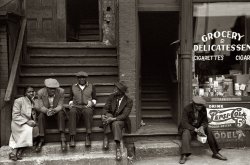
MAY CONTAIN NUTS

Search Shorpy
SHORPY ART

Framed or unframed, desk size to sofa size, printed by us in Arizona and Alabama since 2007. Explore now.
Join and Share
Ad-Free Shorpy
Shorpy is funded by you. Patreon contributors get an ad-free experience.
Learn more.

Recent comments
- Recent view
- Hudson’s Big Store
- Say what??
- Grapes?!
- A Beautiful Moment
- Such joy
- Bethune-Cookman University today...
- Yellow sky at morning
- Side Winder
- Air Quality?
- Sojourner Truth riot
- None were so blind(ed)
- The less famous sister
- Good ol' days?
- Rise and Fall
- Goo Goo Ga Joob
- Ticket Retention
- Not the only one
- Vagaries of War
- Killed by Amtrak
- Back to the Future
- Wanted --
- If you can't stand the light
- Centralized Traffic Control, I believe
- What's really happening
- Heckuva remote control!
- Sometimes — Things Go Bump!
- I SEE THE LIGHT
- Union Switch and Signal Company
- Get That Light Out Of My Eyes
Member Photos
The Shorpy
Print Emporium
Print Emporium
Search Shorpy
Search results -- 30 results per page
- Blatz on Tap: 1939
- ... the lightest hat (5th from right) under the words "Butte Neon" -- now THAT is a bold choice in socks. It brings to mind Nathan Lane's ... more than 50 times already by the fellow under the "Butte Neon" sign by the time this photo was taken.
"Wherever You Go..." ... Posted by Dave - 09/20/2010 - 9:02pm -
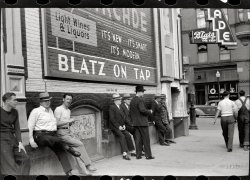
- Back to School: 1950
- ... circa 1950. "Schoolchildren at Hirsch's." Home of the Neon Typo. 4x5 acetate negative from the Shorpy News Photo Archive. View full ... Posted by Dave - 10/18/2016 - 8:43pm -
![Back to School: 1950 Palatine, Illinois, circa 1950. "Schoolchildren at Hirsch's." Home of the Neon Typo. 4x5 acetate negative from the Shorpy News Photo Archive. View full size.
Selfie CityThis collage of 1950 selfies is priceless. The woman's pencil move garnering a stern glare from across the room full of uninhibited kids creating their own topless boy and google eyes classics. Compliments to the photographer.
[Not sure how "selfie" applies here. - tterrace]
The "selfie" tie in that should have been mentioned was this photo reminded me of a collage of selfies made into a large get well card seen at a hospital.
Bare-chested boyTurn around, kid. The shirts are right behind you.
The Lad Under the Lady's ArmPerhaps shopping for a class clown costume?
SpellingThat's the way the British spell the word jewelry over there. I saw it while reading British news sites and thought it was odd the first time I saw the word spelled that way.
[Actually the British would spell it "jewellery." - Dave]
A repurposed store?I wonder what this store was in a previous life. I see very ornate ceiling tiles and crown moldings.
[Pressed-tin ceilings of this type were ubiquitous in stores all across they country from the late-19th century through the first decades of the 20th. The sheets and tiles were mass-produced. - tterrace]
All of the lighting fixtures have the wiring conduit exposed and the sprinkler system appears to be an add on also. As are the fan boxes connected to the windows above the shelves. I wonder if they were used for exhaust or intake? Almost like it was some one’s home.
There are over 72 kids jammed in here. Only 19 0f them are boys which gives them a ratio of 3.8 to 1 girls to boys. Good odds for finding the perfect girlfriend.
I see one boy without a shirt that must have been in a hurry to try clothes on, no dressing room needed.
What is going on with the Teacher's right hand?I see the pencil. Can't figure out all those fingers.
Could this actually beThe first "flash mob"??
Long before WalmartCan anyone figure out what was going on here? Surely, even in a small town with only one clothing store (like the one in which I was raised) we never had it packed to the rafters with kids of all ages like this. Most of the townspeople ordered lots of things from Sears and Wards catalogs via mail order. It is very interesting to see the endless multitude and variety of facial features, sizes and revealing attitudes of all these very different human beings. Maybe we all are "snowflakes" after all. Yet when we see a photo of a flock of dozens of flamingos or an island covered with penguins, they all seem to look exactly the same. Maybe when animals look at clusters of people, we all look the same to them too, but I digress. Can we get a clue as to what this was all about? One boy is totally shirtless. Curiosity killed the cat and I need a story to go with this. Thank you for allowing me into your home or place of business.
Neighbours to the NorthCanadians also spell it as "jewellery", not to mention a host of other British spellings. The lingo is a bit different too. Try this quiz to see how much you know about Canada.
"Kids, C'mon Down!"It looks like several of these kids are holding identical-sized papers/envelopes in their hands. Perhaps their grade cards? Maybe this is a promotion based on getting above-average grades in some class?
The woman may be the teacher of the class. I thought it looked like she was "snapping" her fingers, perhaps to get the attention of the girl looking her way. Maybe her prestidigitation was fast enough to get a double-exposure and double the digits?
At least somebody on the premises knew another way to spell "Jewelry"... it's on the sign above and to the right of the woman's head.
Background storiesSo many things going on here!
I'd love to be in on the exchange between these two girls!
Boom TownThe population of Palatine grew spectacularly between 1940 and 1960, nearly doubling in the first decade and then nearly tripling on top of that in the next. The prewar town was pretty small at 2,222 residents, so it's not terribly unlikely we're seeing the only clothing store in town.
Crammed carsThose cars in the parking lot are sure crammed together.
How could one even open a door to get out?
WinterIt's just around the corner, kids. Boys, you will need those hats with the convertible earmuffs for those snowball fights -- some are sill left in the modern red plaid. It will be aces in the cold! Girls, pretty dresses for all seasons, in all sizes!!
(The Gallery, Chicago, Kids, News Photo Archive, Stores & Markets)](https://www.shorpy.com/files/images/SHORPY-N001.thumbnail.jpg)
- Waste Not: 1918
- ... near where I was staying had put out a bright red flashing neon sign as their holiday decor which simply said "Ole'Jesus".
... Posted by Dave - 09/04/2012 - 4:01pm -
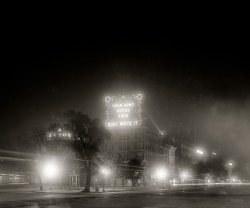
- The Rest of the Store(s)
- ... replaced part of the Acme) still even has its original neon sign on the roof.
Woodmoor Deli The store with the Groceries sign ... Posted by Dave - 11/18/2013 - 6:13pm -
![The Rest of the Store(s) Continuation of the scene last glimpsed here, with the Acme supermarket at right. Silver Spring, Maryland, circa 1948. "Acme Market. Four Corners -- Woodmoor Shopping Center, Colesville Pike and Old Bladensburg Road. Schreier & Patterson, architects." Photo by Theodor Horydczak. View full size.
Three grocery stores?This second photo appears to have a DCS (?) Supermarket at the far left end, another small, unsigned grocery store in the middle, with two men standing in front, plus our Acme Supermarket on the right.
Did that small plaza really have three places selling food items? If so, at least parking was probably always available nearby for each.
FinsThe Cadillac on the right is gorgeous. And at least its owner washes it!
1949 CadillacThe Cadillac on the right is a new 1949 Series 61 coupe, so it must be late 1948 or spring 1949.
'49 is fineGreat looking '49 Cadillac fastback -- a car is a car, but that is a RIDE!
Blast from the PastHave been exchanging email with my sibs over the Acme photos. We grew up in the Four Corners area, ca. 1947--1962 for me. We used to walk past the Acme twice a day, along what was then University Boulevard, to and from St. Bernadette's school (right or to the east).
The "Hardware-Auto Supplies" was (by the fifties) Strosnider's Hardware. I don't remember what most of the other merchants became, but.... The "Groceries" became a savings and loan, where I had my first savings account (which paid more interest--4%--in the mid-fifties than you can get now!). The dark area to the left of "Groceries" was an arcade. Through the arcade on the left was a barber shop and a realty office. On the right was a stair up to the second level, which housed the library, where I spent many an hour. (In later years, the library relocated all the way to the left of the strip.) Also on the right of the arcade was a TV repair shop, where I had many a tube tested.
Bowled ThereThere was a bowling alley downstairs at Woodmoor. It was duckpins of course; even after Fontana's opened around the corner I don't think there were tenpins in that neighborhood until the mid 60's.
Dr. Thibodeaux had his office there for a long time, too.
The Most PowerfulCar in the lot sits proudly by itself! The 1949 Cadillac, in a world still being propelled by flat head six and straight eight puddle jumpers with a maximum horsepower of maybe 120, the brand new 160 horsepower overhead valve V-8 sitting in the second year of the 1948 body, is the wave of the future and the 50's! With its four-speed Hydra-Matic, it can literally peel out of the lot and leave any of the other cars in its dust! When the accelerator is floored, the rear end squats down and the front end rises up with it beautiful hood goddess leading the way!
Still there and much improved The one thing you can not do now is park your Caddy on the shoulder of what is now University Blvd. Also the center of the photo is what is under the Woodmoor sign today. And if that Hardware store would later be Strosnider's Hardware they live on in downtown Silver Spring. The Arcade is still there it leads to a parking lot in the back.
The modern viewI'm pretty sure this is the correct view, today. Interesting to see the contours of the buildings maintained when they built the 2nd floor.
View Larger Map
Even More WoodmoorWoodmoor Shopping Center was developed by Standen and Chester Keller who later developed Beltway Plaza and what would be known as Hechinger Plaza.
The flagpole rises over the area's first Post Office, which moved to larger nearby quarters in August 1961. To its left was the Woodmoor Bakery. A bakery fire in the '60s leveled part of the strip, but second story offices were added during reconstruction.
In addition to their hardware store, Strosnider's also originally ran the 5 & 10, but Strosnider son-in-law Larry Olsen would assume the business; moving it into the old P.O. site. The original 5 & 10 site then became China House Restaurant.
Only phase one of the shopping center is visible in this photo. In the '50s, the strip expanded northward (left) bringing a Peoples Drug Store, Liquor and Gift Stores, the Woodmoor Lanes, a Suburban Trust bank and a larger Montgomery County Library.
The downstairs duckpin alley that Lewisdale John remembers closed suddenly and was replaced for a while by Slot Car Racing. Ultimately, the cozy cellar became the permanent home of the Silver Spring Stage players.
Instant recognitionI recognized Woodmoor instantly, for in spite of many changes of stores the buildings look very much as they did forty years ago, modulo some careful renovation. The florist on the corner (which I think, from this shot, replaced part of the Acme) still even has its original neon sign on the roof.
Woodmoor DeliThe store with the Groceries sign is the old Woodmoor Deli. It was run by two WWII vets - one of which sported a tattoo of a Hula girl captioned New Guinea 1944. I bought my first six pack of beer there long before I should have been allowed to.
That Cadillacmay be a '48. All of the Caddy pics I can find online show only the '48s with a single backup light, although some '48s also had two.
[1948 Cadillacs had three chrome "whiskers" under each taillamp. - Dave]
The 1948 Series 61 Sedanet didn't: note also the single backup light.
2 grocery stores and a deliThere was the Acme Supermarket, the Federal Market and in between (where you see the Groceries sign) was the Woodmoor Deli. The Deli was owned and operated by two WWIi vets - Fred and George I believe. George was a big man and sported a faded tattoo of a Hula Girl captioned "new Guinean 1943).
I bought my first 6 pack in that Deli and though it was not my name, George called me "Marty" for years due to a name printed on an old uniform shirt I wore while pumping gas at the ESSO.
BowlingThe basement duckpin lanes at Woodmoor didn't have automatic machines, but pin spotters who jumped down and reset the pins manually. Fontana's at University and Carroll had two levels - one tenpin and one duckpin; went to many a birthday party there.
In addition to Silver Spring, Strosniders still has thriving locations in Bethesda (Arlington Road & Bradley) and Potomac Village.
Woodmoor SupermarketI lived in the neighborhood behind the Woodmoor Shopping Center, on St. Lawrence Street, for just over a year in the mid 2000s. I bought a ton of wine at the Woodmoor Supermarket/Beer and Wine store. While my wine was usually of the boxed variety, that little store had an impressive beer and wine selection back then.
(The Gallery, Cars, Trucks, Buses, D.C., Stores & Markets, Theodor Horydczak)](https://www.shorpy.com/files/images/SHORPY_5a42645u.thumbnail.jpg)
- Midtown Motors: 1946
- ... fully enlarged image you can make out the reflection of a neon CHEVROLET sign that must have been across the street. Also KFI PACKARD ... Posted by Dave - 09/23/2018 - 7:36pm -
![Midtown Motors: 1946 June 28, 1946. "Midtown Motors, 950 Van Ness Avenue, San Francisco." Back when Ford specialized in making cars. 8x10 inch acetate negative. View full size.
Still there?Google street view shows 40s vintage cars in the windows? Not sure they’re Fords, I’m sure someone else here will know! Right across the street from a Tesla dealership.
Car shoppingI notice that all the vehicles on the showroom floor have drip pans under them.
I want to deal on the little coupe in the foreground.
I remember auto showrooms back then had a nice smell to them of new paint, rubber and some secret ingredient.
InspirationAnyone into the PV series that Volvo produced from about 1947 until 1965 can see where they got the basic design.
950 Van NessYep. Those are vintage Fords in the window of 950 Van Ness. Funny thing. When I lived in the Bay Area, that place(corner of Van Ness and O'Farrell) was a Mercedes Benz dealership.
Yep, still thereIt is now the Academy of Art University Automobile Museum
Here's a link to their web site. Looks like it's worth a visit.
https://academyautomuseum.org/?page_id=13
Oh come on!Am I the only one here who immediately saw the Ford emblem on the hubcaps were not parallel to the floor? How hard would it have been to pop them off and put them on right for the photo?
Packards are Across the StreetI think I'll go browse there. Wonder if that's now the Tesla dealership.
LATER -- Looking the Packard dealership pictures -- seems that this is the place on streetview where they are selling Jaguars.
Ghost marquesChevrolet above the lights; Packard over the stair.
[Also radio station KFI. - Dave]
ReflectionsIn the fully enlarged image you can make out the reflection of a neon CHEVROLET sign that must have been across the street. Also KFI PACKARD vertically. Drip pans under these Fords because there were road tubes for ventilating the engine crankcase and oil would normally accumulate and drip from the tubes.
Competition getting sneakyWhy or from where - the CHEVROLET reversed / reflected above the lower strip of ceiling lights?
[Think hard and I bet you can figure it out. - Dave]
Oxymoron?The caption says Van Ness in S.F. then references KFI which is a radio station in L.A.???
[Auto dealer Earle Anthony owned KFI in Los Angeles, a fact advertised by the KFI sign and giant dummy antennas on the roof of his San Francisco "Palace of Packards" on Van Ness. More reading here and here. Examples of actual oxymorons here. - Dave]
Dave, you outdid yourself.The best watermark ever!
RE: Still There?It's now the Academy of Arts Auto Museum.
https://academyautomuseum.org/
SHORPYx2 on the Watermark! Sometimes more interesting than the photos themselves.
bldg mixup ????image of bldg backin the day on van ness seems ok but DDRESS IS NOT 950 VANNESS AVE. at ofarrel st but a bldg further down strret 900 van ness more or less at ellis street. anyone can back me up. bldg at ellis had the 4 columns and each corner lamppost and 2 stories atall and not 4-5 stories as at 950 vn ness, etc etc.
[You are deeply confused. The photo below shows the building across the street from 950 Van Ness. Get some sleep! - Dave]
(The Gallery, Cars, Trucks, Buses, San Francisco, W. Stanley)](https://www.shorpy.com/files/images/SHORPY-1353A.thumbnail.jpg)
- Chicken in the Ruff: 1960
- ... photo I would love to see that "chicken on a bicycle" neon sign in action!
Don't scratch my Starliner!! The car on the ... Posted by Dave - 11/04/2013 - 5:23pm -
![Chicken in the Ruff: 1960 Extra credit assignment: Identify the cars. (The answers: 1960 Ford Starliner on the left; 1960 Studebaker Lark on the right.)
Spring 1960. "Efforts of John F. Kennedy's campaign team, including members of his family, in West Virginia during Kennedy's quest for the 1960 Democratic presidential nomination. Includes brother Bob at a drive-in in Bluefield." From photos by Bob Lerner for the Look magazine article "The Kennedys: A Family Political Machine." 35mm negative. View full size.
Love that Lark!Nineteen sixty was the first year Studebaker offered its Lark model as a convertible, like the one on which Kennedy is seated. Studebaker differentiated six- and eight-cylinder versions with a Roman numeral "VI" and "VIII," respectively, after the "Lark" badging on the front fenders (I can't quite make out if this one is a VI or VIII).
While sitting on cars wasn't always bad form, especially in the days of heavier-gauge sheetmetal, putting the soles of one's shoes directly on a car's paint job (as RFK is doing to that Ford product parked next to the Lark) is a definite no-no.
1960 Fordon the left, 1959 or 1960 Studebaker Lark on the right
Great photoI would love to see that "chicken on a bicycle" neon sign in action!
Don't scratch my Starliner!!The car on the left is a new 1960 Ford Starliner two door hardtop. The one on the right is a Studebaker Lark. This is a top of the line convertible, but it has a radio "delete" plate on the dash.
On the leftI'm almost sure the car on the left is a new 1961 T-Bird.
[As noted below, the car on the left is a 1960 Ford Starliner. The fender ornament and chrome thingamabobs on the roof pillar are the main clues.]
Snap OnThis picture reminded me of the 2 convertibles that I owned, a 1958 Chevy Impala and a 1963 Olds Starfire. They looked great with the tops down and enclosed in the snap-on faux leather boots that covered them. The car in the photo has the top down but without the boot cover on. After a while I stopped using the cover because it was a real pain to fasten.
Sole solutionRFK's soles are carefully resting on the chrome trim so it's permissible.
Bluefield TwoferBluefield is one of those areas where a savvy pol like our beloved Bobby could have worked two states while thinking he was in only one. The last time I was there (early '60s), my cousins popped me back and forth across the state line several times during a teenage boy's dream night. Good lord to be 14 again!
(The Gallery, Cars, Trucks, Buses, Eateries & Bars, LOOK, Politics)](https://www.shorpy.com/files/images/SHORPY_04891u1.thumbnail.jpg)
- Sierra Motel: 1960
- ... rooms plus that nifty eye-catching, multicolor, two-way neon sign, free TV, in-room telephones and a pool. What else could we possibly ... Posted by rsyung - 08/18/2015 - 11:01am -

- Fill Noir: 1942
- ... a little light-headed over all those signs. And that neon clock. Hope they have those clocks in heaven.
Glassware giveaways and ... Posted by Dave - 09/13/2017 - 10:54am -
![Fill Noir: 1942 April 1942. "Hollywood, California. Gasoline filling station at night." Photo by Russell Lee for the Office of War Information. View full size.
Strange pump?Anyone know what that "pump" is in the center of the front lane? I swear, it looks more like an arcade "Claw Game" cabinet than a gasoline pump, and I've never seen anything like that that I can recall.
Blackout, Shmackout?If the date is right, the picture depicts a pretty blatant violation of the blackout rules, especially two months after the "Battle of Los Angeles."
[Except for the occasional air raid alert (see clipping below), Los Angeles was not under blackout. - Dave]
Film NoirIf it's taught me anything it's that this will soon be the scene of a crime, most likely a murder, or maybe some poor sap will pick up a stranded "dame" at this service station, sending his life careening off the tracks and ending in death.
Still TiredThe location was 6210 Sunset Boulevard at El Centro Avenue. There's still a tire store on the corner.
Cheap washI paid ten bucks for a car wash yesterday ... those were the days!
My oh My that signageGetting a little light-headed over all those signs. And that neon clock. Hope they have those clocks in heaven.
Glassware giveaways and girls on roller skatesMark C. Bloome immigrated to Southern California from Canada in 1924 and parlayed a 15-cent-a-gallon Richfield gasoline station into one of the nation's largest chain with 45 tire stores and service stations
He was a boy when he left Canada to find his fortune and only 22 when he opened his Richfield station at Compton Boulevard and Slauson Avenue in South-Central Los Angeles.
He survived the Depression years by offering glassware giveaways and other free premiums at his expanding chain of stations and at one point even had women on roller skates speeding among the pumps dispensing gasoline.
Bloome was 89 when he died at his Beverly Hills home, Dec.3, 1991
Dave ?EIViego sends a copy of news clipping to support his comment. You offhandedly dispute as we must accept what you say. Where is your support?
[That clipping is from me. Maybe you should read it again! - Dave]
These are the daysAccounting for inflation, 69 cents in 1942 was pretty much exactly the same as the ten bucks you paid for that car wash yesterday, if not just a bit more.
Car WashAccording to the BLI inflation calculator, that 69-cent car wash is equivalent to $10.76 today.
ShowcaseThe "Showcase" gasoline pump was manufactured by at least 3 different companies during the 1930s.
(The Gallery, Gas Stations, Los Angeles, Russell Lee)](https://www.shorpy.com/files/images/SHORPY-8d28143a1.thumbnail.jpg)
- Aeolian Hall: 1919
- ... the Surf.
Light Bulb Sign In the days before neon was used in commercial signs, they often had light bulbs to attract ... pool of bubbles. By the 1920s this could be achieved using neon.
You'll never walk alone On the sidewalk nearest the camera, ... Posted by Dave - 11/10/2020 - 3:29pm -
![Aeolian Hall: 1919 August 1919. "West 42nd Street east from Sixth Avenue, showing Aeolian Hall." And let's not forget the Fleischman Baths. Gelatin silver print by American Studio, New York. View full size.
101 years laterThe trees have grown considerably and hats are hard to find.
Rhapsody in BlueOn February 12, 1924, Aeolian Hall heard the premiere of George Gershwin's "Rhapsody in Blue," with Gershwin at the piano and Paul Whiteman's Orchestra. The audience for this epoch-making event included John Philip Sousa, Igor Stravinsky, and Willie "The Lion" Smith. An acoustic recording, abridged but with the same performers, was made four months later and can be heard on YouTube.
A Plunge That Is Like the SurfNew York Times Feb. 7, 1908:
FLEISCHMAN BATHS OPEN FOR PUBLIC
______________
Company Gives a Fine Entertainment to the Press and Friends
______________
VAUDEVILLE IN SOLARIUM
______________
Diocletian Club to Have Special Privileges
______________
A Plunge That Is Like the Surf.
Light Bulb SignIn the days before neon was used in commercial signs, they often had light bulbs to attract attention. The Fleischman Baths sign has three separate bathers on it. By lighting the men in sequence from top to bottom, it would look like a man diving down the side of the building splashing into a pool of bubbles. By the 1920s this could be achieved using neon.
You'll never walk aloneOn the sidewalk nearest the camera, at the bottom of the photo, there is what appears to be a child walking by herself, arms down at her sides. She's wearing a short dress in a printed fabric, and from her body language and theirs, she seems (to me) not to be accompanied by any of the adults walking just behind her. And from this angle she gives the impression of being transfixed by something she sees. I wish I knew what she was up to that day.
Dr. SimsThe statue of Dr. J. Marion Sims seen on the very right side of the photo was moved from Bryant Park in the 1920's (during subway construction) and then erected in Central Park in 1934. It was removed from Central Park permanently in 2017. It is still in storage, but may someday be restored near his grave in GreenWood Cemetery. Here is the backstory: https://time.com/5243443/nyc-statue-marion-sims/
Re: girl aloneGosh, I hadn’t noticed her till JennyPennifer pointed her out. Now she really pops! Also note the two men in uniform in Bryant Park, near the base of the statue, both caught in near-identical mid-step.
Can anyone read the banner down the street?Last two lines appear to be U.S. Navy and ## East 23rd Street but I can't make out the first two.
[MEN WANTED / FOR THE / U.S. NAVY / 34 EAST 23rd ST. - Dave]
(The Gallery, NYC, Streetcars)](https://www.shorpy.com/files/images/SHORPY-15312u.thumbnail.jpg)
- Fish Grotto: 1957
- ... bow to increase the street presence. I suppose the neon tubes snaking out of the hawseholes are supposed to represent shrouds. Any ... Posted by Rute Boye - 08/04/2012 - 4:40pm -
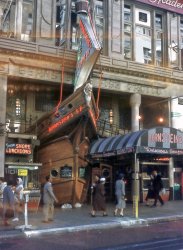
- Brutalist Garage: 1963
- ... to the garage. It's most attractive at night, when the neon under lighting on the base makes the structure glow.
Like a dragonfly ... Posted by Dave - 03/21/2018 - 8:42pm -
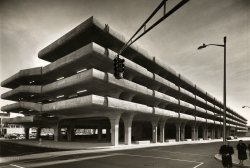
- Oyster House: 1953
- ... good!
Although, I have to say, I prefer their old neon sign:
View Larger Map
So beautifully turned out ... of the property and we are bringing back the old neon sign. I would love to hang a large copy of your picture in the dining ... Posted by Born Too Late - 06/15/2013 - 12:11pm -
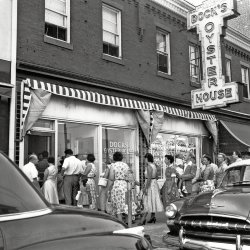
- Jumbo Cola: 1938
- ... in 1933?
Outline around the sign Looks more like neon tube than 'paint shadow' of a removed sign.
(The Gallery, Arthur ... Posted by Dave - 12/18/2016 - 4:49pm -
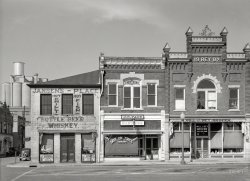
- Chuck Burgers: 1966
- ... Kubla Khan days, but with the letters painted out and the neon rearranged. It's now a tourist souvenir shop. If only the original ... Posted by DFarrow - 07/11/2017 - 10:56pm -
![Chuck Burgers: 1966 The corner of Grant and Bush in San Francisco in 1966. I took this Kodachrome to show Big Ben's, my favorite place for hamburgers while I was in the Navy, stationed on Treasure Island. View full size.
I just knew itI knew if I Googled this address there would be a Starbucks within 50 yards.
[Rotating right brings us to the 1966 angle and the "Dragon Gate," built 1970. -tterrace]
Desirables!Heck, I would like to own any car parked on this street. If I had to prioritize, maybe the Ford panel truck 1st, bug 2nd and then I would struggle to choose. Is that a Studebaker up there in front of the Rambler?
[I see a 1961/3 Rambler American ahead of a yellow Metropolitan. -tterrace]
Yup, tterrace: what's in front of the Rambler American tho? Not sure.
Steam BeerNotice the advert for steam beer leaning against the light pole. I wish I could make out the brewery name, but I can't. Steam beer, also known as California Common, is one of the few original American beer styles, originating in California in the 1800's. It was nearly extinct by the 1960's. Anchor Steam Beer is the prototypical example of modern steam beer.
[The Anchor Brewing Company had just been rejuvenated the previous year. -tterrace]
BullittThat's what this street view reminds me of. Loved Steve McQueen in that movie. The chase scenes are incredible.
Parking excellenceI think this is some of the finest and most consistent parallel parking I have seen. Everyone is close to the curb and has their wheels cut properly for the hill.
Not even hidingGlad to see the VW bug isn't even trying to hide this time. I think it is either a '65 or '66. Kinda hard to tell in the early years. Although yup I would take the old Rambler American too.
Great burgers! Ate there many a time when I worked downtown. I don't know if it was called Big Ben's then though. Happy older Chinese gentleman made them.
Takes a lot of practice to parallel park like that on a hill. I'll take the T-Bird in the middle of the pack.
[You mean that 1962 Ford Galaxie sedan? - Dave]
Yes, that one. Our family had one like it, but it was a convertible. Same color though. The tail light got me on that one.
And I wish I'd visited the Rustic Lodge back then. I bet the interior was something else. Too young in 1966.
1958 PlymouthLooks like Roland LeBay from "Christine" rolled into San Francisco in 1966.
This answers my questionI always wondered where people in San Francisco get their tassels.
Looks Like1963 Dodge Dart, 1964 Mustang and 1962 Chevy in front of the American.
I am usually wrong though, so I come on here merely to be made fun of.
51 yearsAnd still no place to park! Ford panel #1, VW #2 and Galaxie #3, for me. And any left over is fine too.
TasselryWell, here's the thing, OTY: as part of my job in the fab world o' printing, a couple of times a year I have to find special tassels (graduation programs, other ceremonial booklets). So no lie, I went to Google and looked to see if they were still in business. Sadly, long gone. Yes, I need a life. (I think mg2288 is right about the Dodge Dart and 62 Chev, not sure abt Mustang.)
That's some great parking!Impressive parking skills shown on this street! With all of the manual transmissions back then, and all the hills in San Fran, I can only imagine the opportunities for parking fender benders.
Mandarin Cafe buildingThe building where "Big Ben's" was located has gone through some interesting changes - it was built in the mid-1920s as the Mandarin Cafe, a Chinoiserie showpiece which claimed to take architectural inspiration from the Forbidden City in Beijing. It provided dining and dancing with an Oriental flair to a non-Chinese clientele; an ad from the late 1920s in the San Francisco Musical and Theatrical News indicates that Herb Meyerinck's orchestra played there. The cafe - a casualty of the Depression - declared bankruptcy in 1930 and was later refashioned as the Kubla Khan nightclub, which was popular with servicemen during the 1940s. Sometime between then and when this photo was taken Big Ben's took over the premises. The "City Of Hankow" sign is a holdover from the Kubla Khan days, but with the letters painted out and the neon rearranged. It's now a tourist souvenir shop. If only the original interiors had survived - luckily the exterior of the building is mostly intact.
(ShorpyBlog, Member Gallery)](https://www.shorpy.com/files/images/SF009.thumbnail.jpg)
- Making Money: 1912
- ... really available until well into the 30's. Could be neon, but they're pretty bright, and neon wasn't really practical until the 20's.
So, what are those bar ... Posted by Dave - 08/18/2014 - 11:53am -
![Making Money: 1912 Washington, D.C., circa 1912. "Employees at printing presses, Bureau of Engrav­ing and Printing." Harris & Ewing Collection glass negative. View full size.
Fans GaloreA very busy and messy place with rags lying everywhere and a mixture of men and women doing the work. But I am puzzled by the covered things next to every window. They appear to be electric fans.
But why would you have fans near the windows when you have so many already at the ceiling? And why would you have to cover them? Just not turning them on would keep them from blowing all the work around.
A Good Day's WorkAt least the folks in this photo could say they made a lot of money that day.
De-Lighted?Fluorescent Lamps were not commercially available until the end of the 1920's - the lights here must be Mercury-Vapor lamps, invented in 1901 by Peter Cooper-Hewitt, they were more efficient than incandescent lights but gave off a blue-green glow, and were more suited to photography and industry, according to Wikipedia.
200 Cents' WorthThis page of two-dollar banknotes reveals some of the bills here to be Series 1899 $2 silver certificates, a design that was used until 1917. The printing plates blown up by tterrace are for the $1 silver certs.
Print jobsFront reverse printing plate of something and printed reverse of something.
Cooper-Hewitt lightsI've actually seen working lights of this type that were installed in an old home that was being renovated.
They gave off the blue-greenish light, as was stated before.
The lights I saw were not the automatic starting ones. You had to physically tilt the bulb to get the mercury to flow the length of the lamp so it would light.
Probably Paper Dust Galore, TooI notice none of the ceiling fans are running, so I think it must be a cooler season. I imagine the oscillating fans mounted near the windows are covered to prevent them from collecting the horrible amount of paper dust that can generally be found around printing presses and guillotine cutters. When the fans are in use, they'd probably blow the dust away from themselves, but when they're idle, it'd collect, creating a nice little fire hazard. (I know two people whose homes burned to the ground as a result of fires in fans.)
As to why wall fans when you have ceiling fans, I'd imagine it's to get some cross-flow ventilation from those windows, perhaps drawing from the shady north side. Ceiling fans are alright for additional air movement nowadays with our central AC, but in those days, I think you'd want a bit more.
[You'd have better reason to wrap something with heating coils, as anyone switching on an electric heater at the start of the heating season can attest -- dust burns. - Dave]
This looks medieval.Today's presses are a far cry from this literal sweatshop.
The Blur testAnyone whose face is recognizable is moving too slowly.
LightingThe lighting in this shop has me puzzled.
Looks like fluorescent, but they weren't really available until well into the 30's. Could be neon, but they're pretty bright, and neon wasn't really practical until the 20's.
So, what are those bar lights?!?
[As noted below by Bigguy, they are mercury discharge lamps, like the ones seen here and here. Below: ad from 1908. - Dave]
Legal TenderThanks tterrace for the close ups of the plates and reverse. Can anyone supply a pic of the bills themselves? A look through Google images using "1912 US $5 bill" yielded interesting paper money but nothing I thought was close. I did not research exactly what series (or type of currency) would be printing at the Bureau in 1912.
I have always had a fascination with US paper money above the usual everyone has. The designs and issues back in the day are just plain interesting and were works of messaged art. Plus they seemed to change with some regularity. God help us if we tried that nowadays, people wouldn't comprehend it.
That reminds me I need to dust off a few of my GWB $43 bills and spend them at the convenience store.
[The designs of U.S. paper currency have been undergoing drastic changes almost annually for the past few years. Maybe no one notices much because we hardly use it anymore. - Dave]
(The Gallery, D.C., Harris + Ewing)](https://www.shorpy.com/files/images/SHORPY-13403a.thumbnail.jpg)
- Birds of a Feather: 1954
- ... The tower in the background was one of the most beautiful neon creations in Las Vegas. Made up of hundreds of small circular neon lights in soft white, they lit from the bottom to the top (or 'boiled'). ... Posted by Dave - 08/24/2017 - 12:39pm -
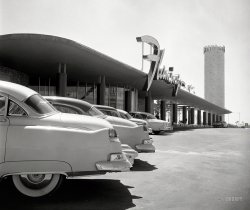
- Tango Palace: 1949
- New York, 1949. Broadway in neon and Kodachrome, courtesy of Shorpy member RalphCS. Where we're waiting to ... Posted by Dave - 04/14/2018 - 2:24pm -
![Tango Palace: 1949 New York, 1949. Broadway in neon and Kodachrome, courtesy of Shorpy member RalphCS. Where we're waiting to get Phil Spitalny's autograph. View full size.
Note the Traffic LightThe traffic lights of the era in NYC featured red and green lights, with no yellow or "caution" light in between. As I recall, to give those approaching a suddenly-turned-red light time to stop or get through the intersection, the red light facing the others stayed red a while longer before turning green and allowing them to proceed.
In 1952, I BelieveA sports Crosley 'Hot Shot' won the Index of Performance at the Sebring 12 Hour race. The Index of Performance was a way to let smaller, less powerful cars win a prize. Interesting cars. They even competed at LeMans in France.
Quo VadisAdvertised here as "in production". Following numerous casting changes and production delays, it was finally released to theaters 2½ years after this photo.
Crossing our path... is a lovely little 1946 or '47 Crosley station wagon. Crosleys, the first of the “econobox” cars in America, were remarkably innovative. The Crosley used a naval marine engine made of welded copper, the first affordable overhead-cam powerplant in an American car. This little buggy also had four-wheel disc brakes, another US first. Crosleys are quite rare today, but have a strong club following.
Cross-country CrosleyBack in the olden days I used to see a number of Crosleys tooling around in Idyllic Larkspur™ and happened to catch one scampering down the main drag in this 1962 slide.
[I wonder if those Toyopets will ever be as popular. -Dave]
Waiting eagerlyFor someone to identify that funny little gray car.
[It's a Crosley. -tterrace]
Loving these in colorMy father drove a cab in NYC while going to NYU in the late '40s. Every time I see a cab in one of these pics, I like to imagine him driving it. B&W photos of this era just don't bring out the same emotion. Color makes the scene come alive.
Thanks RalphCS & Shorpy for providing these. They're terrific!
Roof AstorWhat is that sign in the background at the top "Roof Astor" supposed to mean? Is that the name of the establishment? There's an arrow that seems to point at the roof. Seems really non-intuitive for someone coming in from out of town.
[Refers to the Hotel Astor's Roof Garden. -tterrace]
Traffic Light PhasesThese traffic lights did not go directly from green to red. There was an in-between phase achieved by the green staying on, and the red coming on. Both would be lit briefly to signal Caution, and then the green would go out, leaving just the red light lit.
In summary: Just Green, then Red and Green, then just Red.
Phil Spitalny and His All-Girl Orchestra "Evelyn [Mrs. Spitalny] and Her Magic Violin" were featured soloist and instrument on the Hour of Charm radio program until well after World War II. I have dim memories of their program -- largely over-orchestrated schlock -- but only because one of my cowboy shows came on right after it.
Still more on the traffic lightPerpster has it right on the red/green signal phases, but I'll add that the sequence mentioned was only instituted a number of years into the signalization of the city. Orignally I believe it was Green -> [DARK] -> Red. They decided to replace the [DARK] phase with Red/Green ON in the '40s or early '50s.
I've refurbished one of these pretty little Sherman Tanks of a traffic light for myself:
https://gardenstatesignals.net/my-traffic-signals/#NYCRedGreen
(Kodachromes, Cars, Trucks, Buses, Movies, NYC)](https://www.shorpy.com/files/images/SHORPY-N4-043A.thumbnail.jpg)
- Metropolis: 1910
- ... Detective Agency Somehow I hope that was red neon at night:
Cosgrove's
D-E-T-E-C-T-I-V-E
Agency
Cosgrove's ... Posted by Dave - 07/18/2012 - 3:39pm -
![Metropolis: 1910 New York and the East River circa 1910. "Looking east from the Singer Tower." 8x10 inch dry plate glass negative, Detroit Publishing Company. View full size.
There's always another oneThe traffic on the Brooklyn Bridge, and some previous pictures, showing streetcars less than a block apart, lends credence to the old saying "Never chase girlfriends or streetcars, there's always another one coming right along." Not so true with today's bus systems.
Cosgrove's Detective AgencySomehow I hope that was red neon at night:
Cosgrove's
D-E-T-E-C-T-I-V-E
Agency
Cosgrove's
DETECTIVE
Agency
BMWIn this beautifully busy picture we have the three Lower Manhattan bridges, From south to north or from the bottom of the photo to the top we have The Brooklyn Bridge (opened 1883), The Manhattan Bridge (opened 1909) and The Williamsburg Bridge (opened 1903). An NYC Tour Guide once told me that the easiest way to remember the order of the 3 Bridges is to think of the luxury automobile brand, BMW.
Rogers & Pyatt ShellacUpper rt corner on the NY side ... out of business three years later.
["Shellac in Receiver's Hands" -- sounds messy. - Dave]
RooftopsAnd not an air conditioning unit in sight.
Fletcher's CastoriaThe number of advertisements for Fletcher's Castoria between the Brooklyn and Manhattan bridges is amazing. Talk about saturation marketing.
Brand spanking new!Standing tall in the middle of Brooklyn is the Prison Ship Martyrs' Monument, in Fort Greene. I used to pass this obscure object all the time. Several years ago this extremely out of place memorial piqued my curiosity and I had to do a little research. Around the time of the Revolution people were detained in nearby ships for "crimes" such as not pledging allegiance to the king. It was built in 1908 and magnificently stands over one of the ugliest sections of Brooklyn. Considering that I doubt even one percent of the people who see it daily, are aware of it's its significance, I'm surprised it still stands!
PearlA glimpse of the elevated rail line on Pearl Street.
(The Gallery, Boats & Bridges, DPC, NYC)](https://www.shorpy.com/files/images/4a23362a.thumbnail.jpg)
- Market Street: 1963
- ...
Not much has changed. But, I still miss all of the neon.
What happened to all the people? One thing that is ... Posted by Dave - 07/14/2021 - 11:28am -
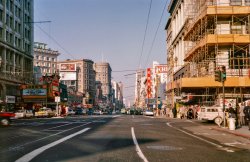
- Tommies Too: 1937
- ... 1937. "38 Price Street." Beer sign by Acme Radio & Neon. Our second look at this mom-and-pop establishment run by Tommie and ... Posted by Dave - 08/30/2012 - 11:03am -
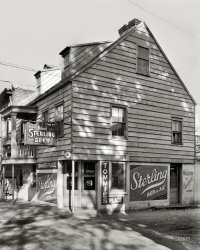
- The Hump Office: 1942
- ... on the console of the Univac 1 at Case Tech, watching the neon lights blink and the metal tapes spin.
C+O's corporate offices were in ... Posted by Dave - 01/16/2014 - 6:12pm -
![The Hump Office: 1942 December 1942. "Switch lists coming in by teletype to the hump office at a Chicago & North Western railroad yard, Chicago." 4x5 Kodachrome transparency by Jack Delano for the Office of War Information. View full size.
The List - Railroad Abbreviations?I can figure out some of the abbreviations in the left column as railroads: SFE = Santa Fe, RDG = Reading, PA = Pennsylvania, NYC = New York Central, RI = Rock Island, MIL = Milwaukee Road. Maybe someone out there can figure out the others: CIM, MP, EJE, COFG, GCX, UTLX, CNW, MDT. I also think the ones in the center column are abbreviations (BELT, PENNA, IHB, IHLOC, CBQ), but of railroads or cities?
20 Years Later...in 1962, a similarly attired C+O clerk, leaning back in a swivel chair, feet up on the console of the Univac 1 at Case Tech, watching the neon lights blink and the metal tapes spin.
C+O's corporate offices were in the Terminal Tower, and a clerk came out to Case every day to run accounting jobs. This was the only use the Univac 1 got at the time, with the Burroughs 220 and the new Univac 1107 taking over student class load.
My phone has more computing power than all of them put together.
Could it be?General MacArthur above the pictured man's head?
[Good catch! Time magazine, December 29, 1941. -tterrace]
The ListClick to enlarge.
Railroad AbbreviationsCIM = Chicago, Illinois, and Midland
MP = Missouri Pacific
EJE = Elgin, Joliet, and Eastern
COFG = Central of Georgia
GCX = General Chemical
UTLX = Union Tank Car Co.
CNW = Chicago & Northwestern
MDT = Merchants Despatch Transportation
Full disclosure: Other than CNW, I had to rely on the magic of the interwebs.
Hump listThe list most likely represents train 284 out of Butler Yard (Milwaukee, Wisconsin) on the Wisconsin Division, with conductor GL Stewart in charge. The 1, 2, 3...designation indicates the first car to go over the hump, the second, etc.
I find in interesting that the official reporting marks of the various railroads are not used. Regarding bigguy1960’s question: CIM represents the Chicago and Illinois Midland railroad. MP represents the Missouri Pacific railroad, often called the Mopac. EJE represents the Elgin Joliet and Eastern railroad, owned by US Steel at the time to handle their product. MDT stood for Merchants Despatch (the “e” is correct) Transportation. CNW was the Chicago and Northwestern railroad, the host railroad for the picture. The X designation in a reporting mark meant the rail equipment was owned by a company other than a railroad. Hence, UTLX refers to the Union Tank Car Company, still with us today.
The “COFG” and “GCX” have me stumped.
The two character designation to the right of the initial/number represents load or empty, and car type. X stands for empty, thus CIM 5449 is an empty “gon,” or gondola. Lines three and four are empty hoppers. Lines 14, 15, 16, 20, 21, 22 and 23 are loads, with a brief description of the lading.
The next block of information indicates which railroad in Chicago the car goes to. The line one through six block will go to the BRC, the Belt Railroad of Chicago. The handwritten twos and sixes are for the pin puller on the hump. He will see a block of six cars and pull the pin “behind six,” instead of scrutinizing each car reporting mark and number.
The two digit number to the right of the off going line represents the cars weight, critically important to the retarder operator. A couple of the cars show “10” tons, and I’m assuming they are wooden sided gons, which would account for their very light relative weight.
Let's dissect a switch listThe very top of the page shows the train's origin and date.
1. The left column is the position number of the car in the train followed by the car initials and number. The double letter indicates car type, i.e.XG, gondola; XM, boxcar, etc.
2. The next column lists the car destination as far as this yard is concerned. Belt would be Belt Railway of Chicago; IHB is Indiana Harbor Belt, with initials after indicating IHB's connecting destination, for instance CBQ is Burlington Route. Most of this train is being delivered to C&NW's connecting railroads in the neighborhood.
3.Third column of typed numbers is the track number the car is headed for. The hand written number shows multiple car cuts. To the right of the track numbers is any special notations or instructions. It looks like "Ride" is the big note, meaning the car should be ridden by a trainman off the hump, to slow the car to prevent damage to lading.
In this time, most humps employed "hump riders", trainmen who controlled speed of cars as they rolled into the tracks by gravity after being uncoupled in motion.
Early in my career, only the yard conductor got a nice printout like this. He would scribble out a simple switchlist for his trainmen that only listed how many cars to which track number. The conductor was the only one who had car numbers to work with; if he missed an extra car, or a car missing, all the work beyond that was wrong and had to be straightened out. (Most guys were careful about that.)
Couple more abbr.BELT = Beltline RR (Chicago local freight)
CBQ = Chicago Burlington & Quincy (Burlington route)
Those Initials and moreCOFG = Central of Georgia (Railroad)
GCX = General Chemical (Company)
WAB - Wabash (Railroad)
The Belt (Railway Company of Chicago) gets all of its empty Railroad owned cars on the same Track 28, but the PENNA (Pennsylvania Railroad) gets its empty PA (Pennsylvania Railroad) cars on Track 10 and an empty RDG (Reading Railroad) car on Track 9.
Thanks, SHORPYAnother learning experience thanks to your superb members.
(The Gallery, Kodachromes, Chicago, Jack Delano, Railroads)](https://www.shorpy.com/files/images/SHORPY_1a34624u.thumbnail.jpg)
- Open All Night: 1940
- ... PLACE sign with the giant apostrophe. The Rheingold beer neon sign would have been a beacon at night. There is no shortage of sidewalk ... Posted by Dave - 10/06/2021 - 11:00am -
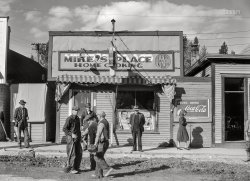
- Dallas After Dark: 1942
- ... Petroleum, later Mobil Oil, it was topped by the rotating, neon-lit Pegasus, put in place for the American Petroleum Institute's 1934 ... the halfway mark. I've heard they found and restored the neon sign and installed it at the Omni hotel downtown.
Does anyone ... Posted by Dave - 11/02/2017 - 5:47pm -
![Dallas After Dark: 1942 January 1942. "Night view, downtown section. Dallas, Texas." Medium format negative by Arthur Rothstein for the Office of War Information. View full size.
Lane and CommerceIt seems I was off in my original post, this isn't Commerce and Lane, it's Commerce and Prather. The depth of field of the Google cameras can be quite different from the vintage photos.
'36 TerraplaneA 1936 Hudson Terraplane sitting at the curb.
The Magnolia BuildingThe main feature here is the Magnolia Building, completed in 1922. Headquarters for Magnolia Petroleum, later Mobil Oil, it was topped by the rotating, neon-lit Pegasus, put in place for the American Petroleum Institute's 1934 convention, hosted in Dallas. A replacement Pegasus sits atop the building today.
Back then, Pegasus was visible for miles, as it was when my mother moved in Dallas the next year. That year (1943), it would be eclipsed in height by the Mercantile Bank Building, the only skyscraper completed during the war, and the tallest building west of the Mississippi. Today the Magnolia Building is the Magnolia Hotel, and the Merc has been converted into apartments.
Pirouetting Pegasus Revolving atop the old Magnolia building, the red flying horse was a Dallas landmark for a couple generations. I remember competing with my brother to be the first to spot it as we drove into "Big D" on our semi-annual trips from Deep East Texas to Abilene. The return trip eastward usually put us in Dallas after dark and the glowing Pegusus was the halfway mark. I've heard they found and restored the neon sign and installed it at the Omni hotel downtown.
Does anyone remember the song Big "D", little "a", double "l"- "a-s" - may have been a jingle?
Goober Pea
John F. Beasley Construction CompanyThis construction company is still going strong in the Dallas area, but the building under construction on the right in our photo didn't survive.
Pegasus rebornHere's the story of the search for, and discovery and restoration of Pegasus.
It's now front of the Omni Dallas, according to this.
Big D, little aThe song "Big D" is from the musical "Most Happy Fella" by Frank Loesser. It's a delightful show, and popular among community theater groups. The same show also includes the show-stopping "Standing on the Corner" (as in "watching all the girls go by").
It's Actually the MercThe building under construction (directly across the street from Neiman-Marcus) did indeed survive, having been completed in 1942 as The Mercantile National Bank. It is presently 'The Merc' apartments. Here's a tidbit from their leasing brochure...
"The Merc is more than a place to live. It is a place of history, rooted in the city's legacy of entrepreneurship, industriousness, and the good life. Completed in 1942, the 523-foot Mercantile Tower with its stately clock and soaring spire was the home of the Mercantile National Bank, founded and owned by Dallas' powerhouse banker and civic leader, Robert L. Thornton. This landmark building has reclaimed its place of honor amidst Dallas' vibrant skyline".
The photo shows The Mercantile National Bank shortly after completion. Neiman-Marcus is directly across the street.
It's actually not the MercNot that it really matters, and not that I want to be contrary, but the building under construction would be in the 1500 block of Commerce, in a spot now occupied by a parking lot (and/or the building now at 1511 Commerce). The Merc is a block to the east of here. Love this photo - now I need to go take a look at the Pegasus next summer during the annual family trip to the Metroplex!
[You're off by two blocks. We're at the 1700 block of Commerce - note the address on the C.E. Hoffman Co. sign. Also, the building at the right, now with additional floors, is at the corner of Commerce and S. Ervay, immediately across S. Ervay from the Merc. -tterrace]
Dang - you're right! I did see the address, but ignored it when I agreed with a previous post that this was the corner of Lane Street, and could not see Ervay passing to the north. I think it's easy to get fooled by the foreshortening difference between these photos and Google street view cameras! I learn something every day from Shorpy! I also shouldn't try to post things when I'm up past my bedtime.
(The Gallery, Arthur Rothstein, Cars, Trucks, Buses)](https://www.shorpy.com/files/images/SHORPY-8b16323a.thumbnail.jpg)
- The Luxe Boat: 1912
- ...
Too Bland It needs slot machines, card tables, neon effects ad nauseam, and oh yes at least one gift shop. Then it would look ... Posted by Dave - 08/02/2012 - 4:14pm -
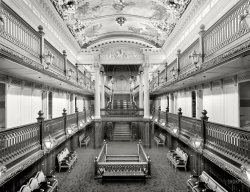
- Triple Cola: 1939
- ... Coca-Cola clock to the right below the Atlantic Ale/Beer neon sign?
[Well duh. Thankyou! - Dave]
Sold American In the ... Posted by Dave - 04/20/2019 - 12:45pm -
![Triple Cola: 1939 November 1939. "Lunch stand and tobacco inside entrance to warehouse at end of auction sale. Durham, North Carolina." Medium format acetate negative by Marion Post Wolcott for the Farm Security Administration. View full size.
Um, erPerhaps blusun meant the Coca-Cola clock to the right below the Atlantic Ale/Beer neon sign?
[Well duh. Thankyou! - Dave]
Sold AmericanIn the back of my mind I can still hear the chants of F.E.Boone and Speed Riggs selling that fine, that ripe, that mild tobacco. Did you know doctors prefer Luckies 2-1?!
Coke-lectableLooking at auctions, the Coca-Cola clock is worth about $6K.
Luckies 2 to 1I threw almost a full pack of luckies in the trash in 1974 after an endless coughing spell - a weak later the cough went away and never returned
Double Cola ClocksThe Coca Cola clock in the right-hand window reminds us that he who has one clock always knows what time it is. He who has two is never quite sure.
Pads of TobaccoI tied many of those bundles of tobacco and knelt in those wooden baskets to pad them up. The baskets are becoming collectors items. I remember well standing in the warehouse to see the auctioneers and buyers pass through and make or break your year.
Times long gone in DurhamWhen I first moved to Durham in the early 1980s, the city still had a sweet, distinctive aroma of curing tobacco in its downtown district. Over the years that fragrance disappeared, and many of these warehouse/auction houses have been leveled to make way for high-dollar condominium complexes. Thank you for a reminder of a simpler time.
The JukeboxWurlitzer Table Model 61 – 1938.
(The Gallery, Eateries & Bars, M.P. Wolcott)](https://www.shorpy.com/files/images/SHORPY-8c11272a.thumbnail.jpg)
- In Transit: 1927
- ... Avenue in Silver Spring, Maryland. They had a large neon sign across the front of their building. In small type it said "One of ... Posted by Dave - 09/13/2011 - 2:02pm -
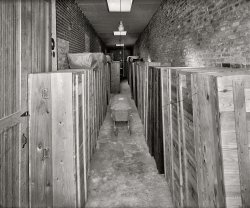
- Dodge for Dummies: 1948
- ... as the building's already sporting the perfect neon logos for Ford's luxury make.
Amazingly This showroom was located ... Posted by Dave - 03/06/2013 - 12:03pm -
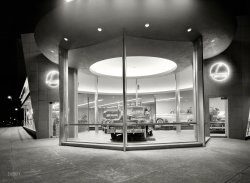
- Gulf Service: 1939
- ... full size.
Star bright When they fire up all that neon, I bet they could guide ships in off the ocean.
Minivan precursor ... Posted by Dave - 04/25/2019 - 6:45pm -
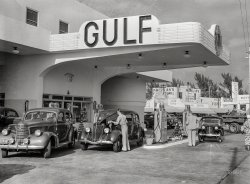
- Frosty Mugs: 1940
- ... Next Stop Pottersville That is some glorious curlicue neon in the Sun-Set bar's windows. I can picture George Bailey running past ... Posted by Dave - 12/16/2019 - 1:54pm -
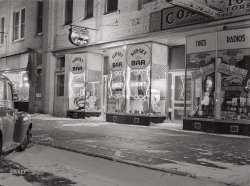
- South Side Deli: 1941
- ... how we can see the items for sale stacked up simply...! No neon signs here!
(The Gallery, Chicago, Russell Lee, Stores & Markets) ... Posted by Dave - 09/09/2011 - 7:10pm -
